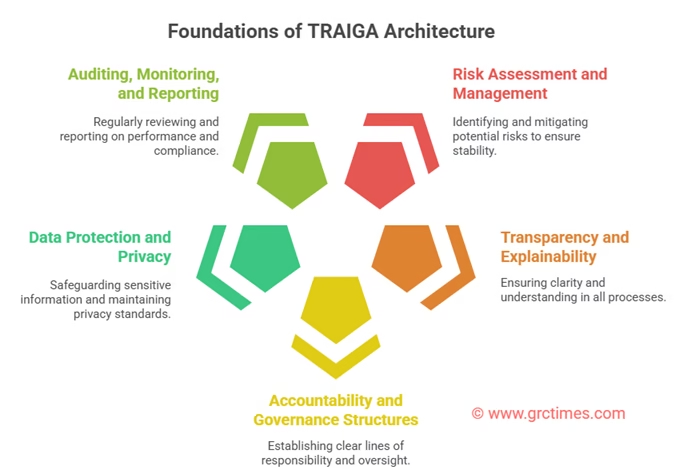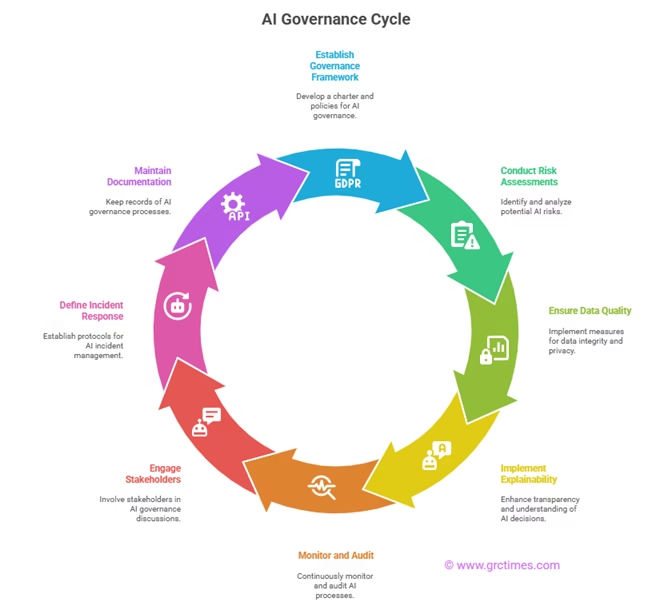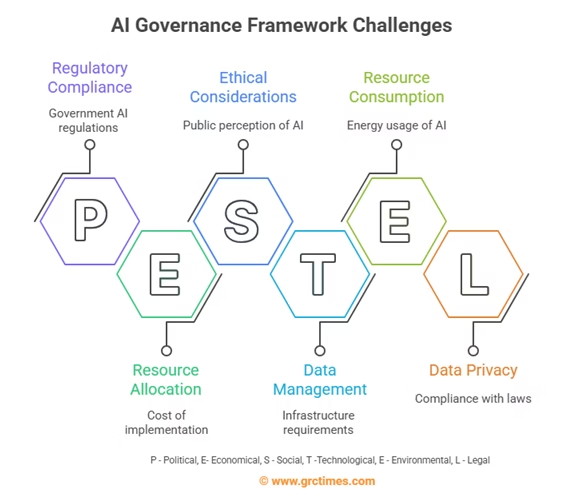Artificial intelligence (AI) has become a cornerstone technology across industries, powering everything from customer service chatbots and medical diagnostics to predictive maintenance and autonomous vehicles. Yet, mounting concerns around biases, opaque decision-making, privacy infringements, and systemic risks have prompted policymakers to act. The Responsible Artificial Intelligence Governance Act (TRAIGA) represents a watershed moment: the first unified federal statute that imposes obligations on AI developers, deployers, and users to embed ethics, transparency, and accountability into every phase of the AI lifecycle. While TRAIGA’s aspirations are ambitious, compliance need not be onerous. Instead, organizations can leverage existing frameworks—such as ISO/IEC 42001 for AI management systems, NIST’s AI Risk Management Framework, and principles from global guidelines—to architect a pragmatic governance program that not only satisfies regulators but also drives competitive differentiation.
Table of Contents
Historical Context and Legislative Drivers
The legislative journey toward TRAIGA began with mounting public scrutiny over high-profile AI failures: facial recognition systems misidentifying individuals of minority ethnicities, algorithmic lending platforms perpetuating socioeconomic disparities, and opaque content moderation algorithms stifling free speech. In response, bipartisan congressional hearings in 2022 and 2023 highlighted the absence of a unified regulatory framework in the United States, unlike the European Union’s proposed Artificial Intelligence Act. Key drivers leading to TRAIGA’s enactment include:
- Societal Risks and Bias Incidents: Documented cases of algorithmic discrimination spurred calls for binding rules rather than voluntary ethics principles.
- National Security and Critical Infrastructure: Government agencies underscored the strategic imperative to secure AI systems against adversarial attacks and ensure reliability in defense, healthcare, and utilities.
- Global Competitive Dynamics: U.S. regulators sought to balance innovation leadership with safeguards, avoiding the pitfalls of over-regulation while preempting fragmented state-level mandates.
- Stakeholder Advocacy: Civil society organizations, consumer groups, and academic researchers championed robust audit requirements and whistle-blower protections for AI harms. These converging pressures culminated in bipartisan legislation introduced in mid-2024 and signed into law by the President in November 2024. TRAIGA’s final text reflects extensive stakeholder input, carving out a comprehensive framework that balances prescriptive requirements with principles-based flexibility.
Scope and Applicability of TRAIGA
TRAIGA applies broadly to any “AI System”—defined as software that uses statistical or machine-learning techniques to perform tasks requiring human-like capabilities—when the system is:
- Developed, deployed, or sold for commercial use in the United States.
- Employed by federal agencies for decision-making, including administrative, licensing, or enforcement actions.
- Integrated into critical infrastructure sectors (energy, finance, healthcare, transportation) where risks to public safety or societal welfare are elevated. Excluded from TRAIGA’s scope are purely research prototypes not deployed in operational settings, open-source models disseminated without commercial intent, and AI systems operated exclusively by individuals for personal use. However, organizations should carefully assess borderline cases—especially research-to-production transitions—to ensure proper classification and compliance.
Core Pillars and Key Provisions
TRAIGA’s architecture rests on five interlocking pillars, each mandating specific organizational practices:

Risk Assessment and Management
TRAIGA requires organizations to conduct pre-deployment and periodic risk assessments that evaluate:
- Algorithmic bias (disparate impact on protected classes).
- Safety and operational hazards (e.g., autonomous vehicle malfunctions).
- Privacy risks (unauthorized inference or re-identification).
- Robustness against adversarial inputs or data poisoning. Assessments must be documented in formal risk registers, scored based on likelihood and severity, and used to inform mitigation strategies.
Transparency and Explainability
Developers must maintain comprehensive documentation covering:
- Data provenance: origins, collection methods, and dataset composition.
- Model architecture: algorithms, hyperparameters, training procedures, and performance metrics.
- Decision logic: techniques used to interpret or approximate model rationale. Furthermore, organizations must provide user-friendly explanations for automated decisions affecting individuals—drawing on methods like SHAP, LIME, counterfactual explanations, and visual dashboards.
Accountability and Governance Structures
TRAIGA stipulates that each organization designate a Chief AI Governance Officer (CAIGO) responsible for overall compliance and liaison with regulatory authorities. Governance structures should include:
- Cross-Functional AI Governance Committee: Bring together legal, compliance, technical, security, and business representatives to oversee AI initiatives, review risk registers, and approve high-impact projects.
- Escalation Paths: Define clear thresholds—e.g., risk scores exceeding set limits or incident severity levels—that trigger committee reviews and executive notifications.
- Performance Incentives: Link portions of leadership and team compensation to adherence to governance metrics—such as timely audit completion, bias mitigation success rates, or reduced incident recurrence.
- Role-Based Training Mandates: Require annual certifications for CAIGO, committee members, data scientists, and legal counsel on TRAIGA obligations and updates.
- Regulatory Engagement Protocols: CAIGO must maintain up-to-date registrations with the AI Regulatory Commission, submit quarterly compliance attestations, and participate in industry working groups to influence rulemaking.
Data Protection and Privacy
Under TRAIGA, organizations must integrate privacy-by-design and data-minimization throughout the AI lifecycle:
- Anonymization and Pseudonymization Techniques: Apply k-anonymity, l-diversity, and differential privacy to remove personally identifiable information while retaining analytic utility.
- Encryption Standards: Enforce AES-256 encryption for data at rest and TLS 1.3 for data in transit. Key management should leverage hardware security modules (HSMs) and rotate keys at least every 12 months.
- Data Retention Policies: Define retention schedules aligned with business needs and legal requirements. Automatically delete or archive data older than the retention period, with periodic audits to verify compliance.
- Consent Management Systems: Implement dynamic consent frameworks that allow individuals to grant, revoke, or modify permissions for data use. Log all consent transactions for auditability.
- Privacy Impact Assessments (PIAs): Conduct PIAs for each new AI use case involving personal data, documenting data flows, risk ratings, and mitigation controls. Update PIAs whenever datasets or model objectives change.
- Third-Party Data Sharing Controls: Enforce contractual data handling obligations, conduct vendor risk assessments, and require third-party certification of privacy controls.
Auditing, Monitoring, and Reporting
Continuous oversight and independent verification are cornerstones of TRAIGA compliance:
- Real-Time Monitoring Dashboards: Implement dashboards that display key metrics—accuracy by subgroup, false positive/negative rates, demographic parity, and data drift indicators. Set automated alerts for threshold breaches.
- Internal Audit Cadence: Schedule quarterly internal audits by a dedicated AI audit team to review governance documentation, risk registers, incident logs, and model performance metrics. Use standardized audit checklists aligned to TRAIGA requirements.
- Independent Third-Party Audits: Engage accredited auditors annually to perform comprehensive assessments of governance frameworks, technical controls, and operational processes. Prepare audit readiness materials—model cards, data sheets, risk registers—for auditor review.
- Incident Reporting Protocols: Mandate reporting of any significant AI-related incident—bias events, safety failures, privacy breaches—to the AI Regulatory Commission within 30 days. Reports must include incident description, root cause analysis, affected populations, remediation actions, and timeline for corrective measures.
- Corrective Action Plans: For any audit or incident finding, develop a formal remediation plan with assigned owners, deadlines, and validation criteria. Track progress in a governance portal and verify completion before next audit cycle.
Best Practices for Compliance

Establishing an AI Governance Framework
Develop a comprehensive framework that formalizes policies, processes, and governance bodies:
- Governance Charter: Draft a charter outlining scope, objectives, roles, decision-making authorities, and performance metrics. Secure executive endorsement to ensure organizational buy-in and resource allocation.
- Policy Library: Create a repository of AI governance policies covering risk management, data stewardship, model development, procurement, incident response, and vendor management. Version-control these policies and subject major revisions to governance committee approval.
- Governance Committee Operations: Define committee meeting cadence (e.g., monthly tactical sessions, quarterly strategic reviews), agendas, decision logs, and stakeholder communication plans. Ensure minutes and action items are documented and tracked.
- Integration with ERM: Incorporate AI-related risks into the enterprise risk management (ERM) program. Align risk scoring methodologies and reporting channels to provide senior leadership with a unified risk view.
- Vendor Governance: Establish processes to evaluate third-party AI tools and services. Require proof of TRAIGA compliance, conduct on-site or virtual assessments, and include contractual SLAs for governance obligations, audit rights, and data protection guarantees.

Conducting Comprehensive Risk Assessments
Implement a repeatable, data-driven risk assessment process:
- Risk Assessment Framework Selection: Choose an established framework (e.g., NIST AI RMF, ISO/IEC 42001) and customize risk categories—bias, safety, privacy, security—to organizational context.
- Risk Identification Workshops: Convene cross-functional workshops—data science, legal, compliance, business units—to brainstorm potential risks for each AI use case. Document risks in a centralized register.
- Quantitative and Qualitative Analysis: For each risk, assign likelihood and impact scores using quantitative data where available (e.g., historical incident rates, bias test results) and expert judgment for qualitative factors.
- Mitigation Strategy Development: For high-priority risks, define specific controls—bias mitigation algorithms, adversarial robustness tests, privacy-enhancing technologies—and assign owners and timelines.
- Risk Acceptance and Escalation: Define clear criteria for risk acceptance, tolerance thresholds, and escalation procedures for risks exceeding appetite. Document decisions in risk committee minutes.
- Periodic Risk Review: Schedule biannual risk register reviews or trigger reviews upon significant model changes—new data sources, algorithmic updates, or expanded deployment contexts.
Ensuring Data Quality, Integrity, and Privacy
Adopt rigorous data governance and technical controls:
- Data Cataloging and Lineage: Implement metadata management tools to catalog datasets, track lineage, maintain data dictionaries, and record stewardship information.
- Data Validation Pipelines: Build automated pipelines that enforce schema checks, missing value detection, outlier identification, and label consistency verification. Incorporate manual reviews for high-impact datasets.
- Privacy-Enhancing Technologies (PETs): Deploy differential privacy, secure multi-party computation, and homomorphic encryption for sensitive data processing. Evaluate privacy budgets and performance trade-offs.
- Anonymization Best Practices: Combine k-anonymity with l-diversity or t-closeness to prevent re-identification. Regularly test anonymization robustness against known attack techniques.
- Data Retention Enforcement: Automate data purging workflows using lifecycle management tools. Retention policies should consider business value, regulatory requirements, and model reproducibility needs.
- Consent and Preference Management: Integrate consent management platforms to capture, store, and enforce user data preferences. Provide audit logs for consent changes.
Implementing Explainability and Interpretability Measures
Select and integrate tools that provide both local and global model insights:
- Global Explainability: Use SHAP summary plots, feature importance charts, and partial dependence plots to understand overall model behavior and identify dominant predictors.
- Local Explainability: Offer LIME explanations, counterfactual examples, or anchor points for individual predictions, enabling end users and stakeholders to see “what-if” scenarios.
- Model Cards and Datasheets: Publish model cards detailing intended use cases, performance metrics across demographic groups, ethical considerations, and caveats. Create datasheets for datasets describing collection methods, provenance, and known limitations.
- User Interfaces for Transparency: Develop dashboards or APIs that allow authorized users to query model explanations, view prediction rationales, and submit feedback on decision accuracy or fairness concerns.
- Continuous Validation of Explanations: Monitor shifts in feature importance distributions and explanation coherence metrics. Significant deviations may indicate model drift or data distribution changes requiring retraining or reevaluation.
Designing Continuous Monitoring and Audit Programs
Ensure ongoing compliance through proactive oversight:
- Define Monitoring KPIs: Identify and instrument metrics for fairness (e.g., demographic parity difference), performance (accuracy, precision, recall), robustness (input perturbation sensitivity), and privacy (differential privacy budgets).
- Alerting Framework: Configure automated alerts in monitoring platforms for KPI violations. Classify alerts by severity and define triage workflows.
- Internal Audits: Create audit teams with representation from compliance, technical, and business functions. Use audit frameworks to assess policy adherence, documentation completeness, and control effectiveness. Document findings in audit reports.
- Third-Party Audit Engagement: Select auditors with AI expertise and relevant accreditation. Develop audit scopes that cover end-to-end processes—from data collection to decision outcomes. Prepare evidence packages—logs, policies, meeting minutes—in advance.
- Audit Remediation Tracking: Use governance platforms to log findings, assign remediation tasks, set due dates, and verify completion. Establish executive reporting on remediation progress.
- Regulatory Submissions: Develop standardized templates for audit summaries and incident reports. Automate generation of compliance attestations and submit via AI Regulatory Commission portals.
Engaging Stakeholders and Building Organizational Culture
Cultivate a culture of ethical AI and shared responsibility:
- Role-Based Training Programs: Develop tailored curricula—technical deep-dives for data scientists, high-level overview for executives, policy and legal implications for compliance teams. Include hands-on labs and scenario exercises.
- Ethics Roundtables: Host regular forums where cross-functional teams discuss emerging AI ethics topics, share lessons learned from incidents, and preview upcoming projects for early feedback.
- Hackathons and Sandboxes: Organize internal hackathons to prototype bias mitigation approaches or safety tests. Provide sandbox environments with synthetic data to experiment without risking production systems.
- Communications Strategy: Publish monthly newsletters, intranet posts, and video briefs highlighting AI governance achievements, upcoming regulatory changes, and best practice case studies.
- Stakeholder Advisory Panels: Engage external experts—academics, ethicists, consumer advocates—to review governance policies and provide independent feedback on high-risk AI use cases.
- Whistleblower and Feedback Channels: Implement confidential reporting mechanisms for employees and external stakeholders to raise AI concerns. Ensure non-retaliation policies and track reports through resolution.
Defining Incident Response, Remediation, and Reporting Protocols
Prepare structured procedures for AI failures and harms:
- Incident Classification Matrix: Define incident categories—minor (e.g., slight performance degradation), major (e.g., biased outputs), critical (e.g., safety breach). Map each to required response SLAs.
- Rapid AI Response Team (RART): Establish a cross-disciplinary team—data scientists, security engineers, legal counsel, PR—to coordinate incident triage, investigation, and communications.
- Containment Playbooks: For each incident type, pre-define immediate containment actions—model rollback, decision throttling, manual review escalation—to limit harm.
- Root Cause Analysis (RCA): Use formal RCA techniques (Five Whys, fault tree analysis) to identify underlying causes—data drift, code defects, process gaps—and document them in incident reports.
- Regulatory Notification: Submit detailed incident reports to regulatory bodies within 30 days, including incident summary, impact assessment, RCA findings, remediation actions, and preventive measures. Notify affected individuals per privacy breach requirements when personal data is implicated.
- Post-Incident Reviews: Conduct lessons-learned sessions with broader teams to update risk registers, refine monitoring thresholds, enhance training, and adjust policies. Document changes and communicate them organization-wide.
Maintaining Robust Documentation and Recordkeeping
Comprehensive, tamper-evident records underpin audit readiness:
- Versioned Model Repositories: Store model code, training scripts, hyperparameter configurations, and environment specifications in version control systems. Tag releases corresponding to audit cycles and production deployments.
- Data Catalog and Lineage Logs: Use metadata management tools to generate and preserve lineage graphs, dataset schemas, and access logs. Ensure immutable storage of critical metadata.
- Risk and Audit Logs: Centralize risk registers, audit checklists, meeting minutes, and incident reports in governance platforms with audit trails.
- Policy and Training Archives: Archive all policy documents, training materials, certification records, and attendance logs. Define retention schedules aligned with compliance requirements.
- Automated Logging Pipelines: Instrument AI pipelines to auto-generate logs for model predictions, bias test results, monitoring alerts, and data drift events. Store logs in secure, queryable data stores for analysis and audit.
Implementation Roadmap and Timeline
- Phase 1 (0–3 Months): Executive sponsorship, AI inventory, governance charter, CAIGO appointment, initial policy drafts.
- Phase 2 (3–6 Months): Select risk and data governance frameworks, pilot risk assessments, integrate monitoring tools, draft PIAs.
- Phase 3 (6–9 Months): Deploy explainability solutions, launch training programs, conduct internal audit of pilot projects.
- Phase 4 (9–12 Months): Engage third-party auditors, finalize incident response playbooks, refine remediation processes, achieve full production readiness.
- Phase 5 (12+ Months): Complete annual independent audit, incorporate audit learnings, update governance framework, and prepare for evolving regulatory requirements.
Organizational Roles, Responsibilities, and Skillsets
- Chief AI Governance Officer (CAIGO): Program ownership, regulatory liaison, executive reporting.
- AI Governance Committee: Strategic oversight, policy approval, risk appetite setting.
- Data Scientists/ML Engineers: Implement bias tests, interpretability techniques, robustness assessments.
- Privacy and Legal Officers: Conduct PIAs, draft vendor contracts, manage regulatory filings.
- Security Architects: Enforce encryption, access controls, secure pipelines.
- Internal Auditors: Evaluate compliance, document findings, track remediations.
- Communications and PR: Manage disclosures, crisis communications, stakeholder engagement.
TRAIGA marks a pivotal shift toward mandated ethical governance of AI in the United States. Organizations that embed these best practices—anchored in robust frameworks, technology investments, and cultural commitment—will not only achieve compliance and avoid significant penalties but also unlock sustainable competitive advantage through trustworthy AI innovation. As the regulatory landscape evolves, forward-looking entities should monitor proposed amendments around global data transfer interoperability, AI certification schemes, and expanded public-sector reporting obligations. Early investment in scalable governance will position organizations to adapt swiftly to future requirements and shape the next generation of responsible AI standards.
Frequently Asked Questions
1. What entities fall under TRAIGA’s scope?
Any organization developing, deploying, or commercially using AI systems in the U.S., including federal agencies and critical infrastructure operators.
2. When did compliance become mandatory?
Existing systems required compliance by January 1, 2025; new deployments must adhere upon launch.
3. What penalties exist for non-compliance?
Organizations face fines up to $5 million per violation and potential suspension of non-compliant AI products.
4. How often are audits required?
Annual independent audits are mandatory, supplemented by quarterly internal reviews and continuous monitoring.
5. Can small businesses obtain exemptions?
Low-risk applications may qualify for scaled requirements—smaller audit scopes and documentation standards—subject to regulator approval.
6. Do open-source models need compliance?
Yes, if integrated into commercial or operational systems, open-source models require full risk assessments, documentation, and monitoring per TRAIGA.
7. Does TRAIGA apply to generative AI?
Yes—generative AI used in decision-making, content moderation, or affecting individual rights must meet transparency and bias testing obligations.
